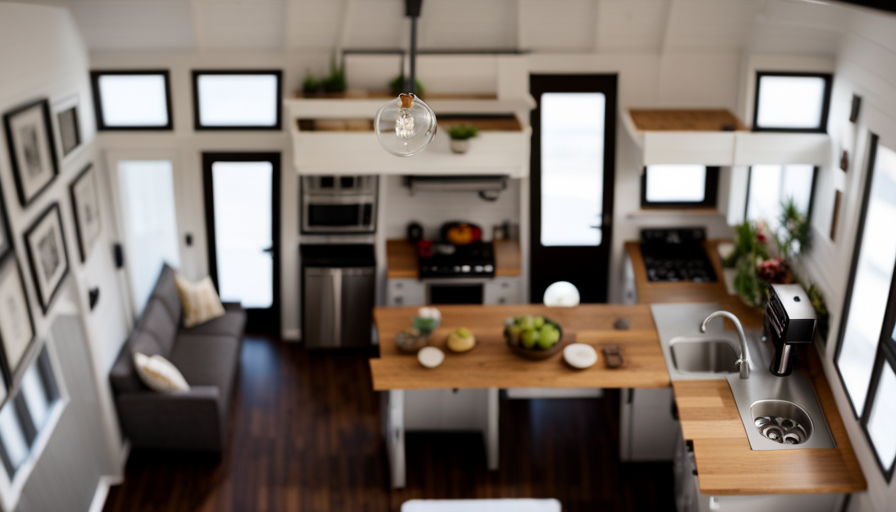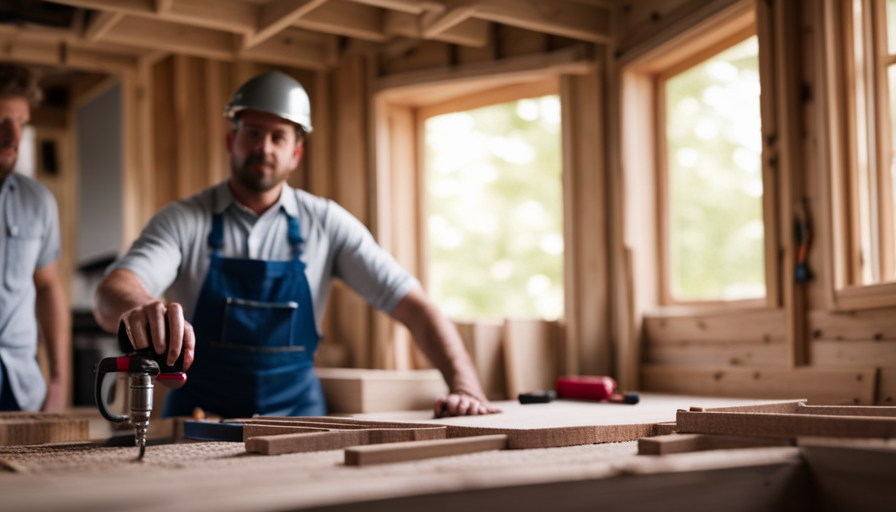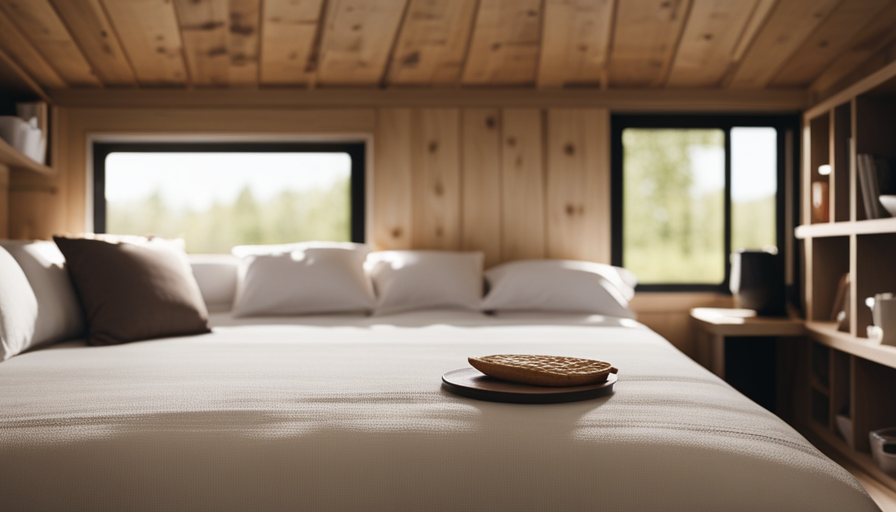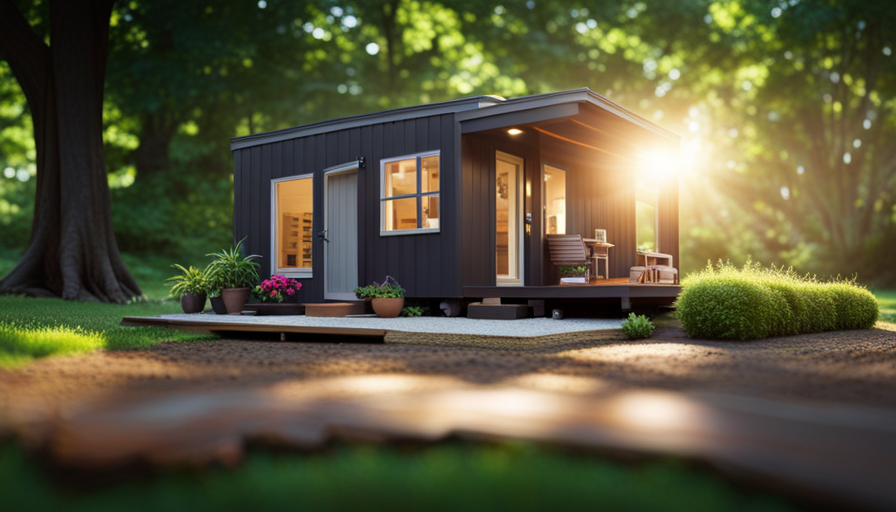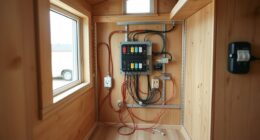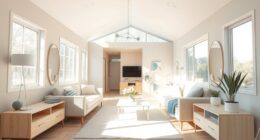Welcome to the world of tiny homes, where every inch is thoughtfully designed to maximize both functionality and comfort, pushing the boundaries of traditional space concepts.
Like a puzzle waiting to be solved, these compact dwellings offer a unique opportunity to embrace a simplified lifestyle.
Imagine, if you will, a miniature sanctuary measuring 400 square feet. Within this cozy abode, every nook and cranny serves a purpose, ensuring that no space is wasted. But what about the length? Ah, that is where the enchanting dimensions of an 8’6” tiny house come into play. This petite haven stretches itself, like a graceful dancer, to accommodate your needs while maintaining a harmonious balance between form and function.
Join me on an exploration of tiny house dimensions, from the length of an 8’6′ dwelling to the art of maximizing space in a compact living environment. Together, we will uncover the design features, storage solutions, and outdoor living areas that make these miniature marvels a truly remarkable living option.
So, let us embark on this journey of discovery and find the perfect tiny house for your unique lifestyle.
Key Takeaways
- 8’6" 400 square foot tiny houses are designed to challenge conventional notions of space and offer a simplified lifestyle.
- These tiny houses maximize functionality and comfort through meticulous design, utilizing every inch of space to create functional living areas.
- Storage in these tiny houses is maximized by utilizing vertical space, with wall-mounted shelves, lofted beds, hanging organizers, and overhead cabinets.
- Multi-functional furniture and a minimalist interior design approach create the illusion of more space and openness in these small homes.
Understanding Tiny House Dimensions
Imagine walking into a cozy 8’6” 400 square foot tiny house and feeling the snugness of its dimensions surround you like a warm embrace. Tiny house design is all about maximizing space and functionality, and choosing the right materials is crucial in achieving this goal. From the moment you step inside, you’ll notice how every inch of the tiny house is carefully thought out and utilized.
The compact size of the tiny house allows for efficient use of space, with clever storage solutions and multi-purpose furniture. The design of the tiny house ensures that no space is wasted, creating a cozy and inviting atmosphere.
When it comes to the length of an 8’6” tiny house, it typically measures around 8 feet and 6 inches. This compact size allows for easy transportation and maneuverability, making it ideal for those who want the flexibility to move their tiny house to different locations. The length of the tiny house is optimized to provide enough living space while still maintaining a compact and portable design.
In the subsequent section about the length of an 8’6” tiny house, we will explore how this dimension impacts the layout and functionality of the space.
The Length of an 8’6" Tiny House
With its compact dimensions, an 8’6′ tiny abode is akin to the old adage: good things come in small packages. The length of an 8’6′ tiny house is exactly 8 feet and 6 inches, which is about the width of a standard parking space. This length allows for easy transportation and maneuverability, making it ideal for those who want to take their tiny home on the road or move it to different locations.
When it comes to the width of an 8’6′ tiny house, it’s typically around 8 feet. This width provides enough space for functional living areas such as a kitchen, bathroom, and sleeping quarters. Despite its narrow width, clever design and efficient use of space can create a comfortable living environment.
As for the height of an 8’6′ tiny house, it’s usually around 13 feet 6 inches. This height allows for a comfortable ceiling height inside the tiny house while still being within the legal limits for transportation on the road.
Exploring the floor plan of a 400 square foot tiny house, you’ll find that every inch is carefully utilized to maximize functionality and livability without sacrificing comfort.
Exploring the Floor Plan of a 400 Square Foot Tiny House
Take a tour through the floor plan of this cozy 400 square foot abode and discover how every nook and cranny is cleverly utilized for maximum functionality and comfort.
-
Loft Bedroom: The tiny house features a loft bedroom located above the main living area. This space-saving design allows for a separate sleeping area while maximizing the floor space below.
-
Open Living Area: The main living area serves multiple purposes, functioning as a living room, dining room, and workspace. The open layout creates a sense of spaciousness while providing flexibility for various activities.
-
Efficient Kitchen: The kitchen is designed to be compact yet efficient, with a small refrigerator, stove, and ample storage space for cookware and utensils. The layout ensures that everything is within reach, minimizing unnecessary movement while preparing meals.
-
Multipurpose Bathroom: The bathroom in this tiny house is designed to serve multiple functions. It includes a toilet, shower, and sink, all cleverly arranged to make the most of the available space. Additionally, there is built-in storage for toiletries and linens.
By exploring the floor plan of this 400 square foot tiny house, you can see how every inch is maximized for functionality and comfort. The layout of the loft bedroom, open living area, efficient kitchen, and multipurpose bathroom all contribute to creating a compact living environment that’s both practical and enjoyable.
In the next section, we’ll delve deeper into the strategies for maximizing space in this small but well-designed home.
Maximizing Space in a Compact Living Environment
Step into a world of boundless possibilities as you unlock the secrets to maximizing space in this compact living oasis. In a tiny house, every square inch counts, and finding ways to maximize storage is key. One effective strategy is to utilize vertical space. By taking advantage of the height of the tiny house, you can create additional storage areas without sacrificing precious floor space.
To illustrate this concept, consider the following table:
| Storage Idea | Description | Benefits |
|---|---|---|
| Wall-mounted shelves | Install shelves on the walls to store books, decorations, and other small items. | Saves floor space and adds a decorative element. |
| Lofted bed | Place the bed on a lofted platform, creating storage space underneath for clothing, shoes, and other belongings. | Maximizes floor space and provides a designated sleeping area. |
| Hanging organizers | Utilize hanging organizers on doors or walls to store accessories, cleaning supplies, and toiletries. | Keeps items easily accessible and frees up drawer space. |
| Overhead cabinets | Install cabinets above kitchen counters or in bathrooms to store dishes, toiletries, and other essentials. | Utilizes space that would otherwise go unused and keeps items organized. |
By incorporating these storage ideas, you can make the most of your compact living environment. With a focus on utilizing vertical space, you can create a functional and organized tiny house. In the next section, we will explore design features to consider in a small home, seamlessly transitioning from maximizing space to enhancing the overall design.
Design Features to Consider in a Small Home
Consider incorporating design features such as multi-functional furniture and clever use of natural light to enhance the aesthetic appeal and functionality of your compact living space. In a small house, effective small space organization is crucial for maximizing every square foot.
One way to achieve this is by utilizing multi-functional furniture that serves more than one purpose. For example, a sofa that can be transformed into a bed or a coffee table that doubles as storage. This not only saves space but also adds versatility to your living area.
Another important aspect of designing a small home is to embrace minimalist interior design. By keeping the design simple and clutter-free, you create an illusion of more space. Opt for neutral colors and clean lines to create a sense of openness. Additionally, consider using mirrors strategically to reflect natural light and make the space appear larger.
Incorporating these design features will not only make your tiny house more visually appealing but also improve its functionality. By utilizing multi-functional furniture and adopting a minimalist approach, you can create a comfortable and efficient living space.
In the next section, we will explore tips for living comfortably in a tiny house, including storage solutions and maximizing outdoor space.
Tips for Living Comfortably in a Tiny House
Embrace the art of compact living and discover the secrets to creating a cozy haven in your small abode. Living in a tiny house may seem daunting at first, but with these tips for organizing, you can make the most of your limited space.
-
Utilize vertical storage: Maximize every inch of space by mounting shelves, hooks, and racks on the walls. This allows for efficient storage of items such as kitchen utensils, clothing, and even plants.
-
Multi-purpose furniture: Invest in furniture that serves multiple functions. A sofa that can transform into a bed, a coffee table with hidden storage compartments, or a dining table that can be folded away when not in use can save valuable space.
-
Declutter regularly: Keep your tiny house organized by regularly decluttering and getting rid of items you no longer need or use. This’ll prevent unnecessary clutter from accumulating and taking up precious space.
-
Use storage containers: Invest in storage containers that can fit neatly under beds or in closets. These containers can be labeled and stacked, making it easy to locate items without creating a mess.
By following these tips for organizing, you can create an organized and comfortable living space in your tiny house. Transitioning into the subsequent section about creative storage solutions for limited space, you can explore innovative ways to maximize storage and make the most of your compact dwelling.
Creative Storage Solutions for Limited Space
When it comes to living comfortably in a tiny house, one of the biggest challenges is finding enough storage space for all your belongings. In a small living area, every square inch counts, which is why creative storage solutions are essential.
One effective strategy is to maximize closet organization. By utilizing various storage accessories like hanging rods, shelves, and shoe racks, you can make the most of your limited closet space.
Additionally, consider implementing hidden storage solutions throughout your tiny house. This can include built-in drawers under your bed, storage compartments under seating areas, and wall-mounted cabinets with concealed shelves. These hidden storage options not only help keep your living space clutter-free but also make the most of every available inch of your tiny house.
By incorporating these storage techniques, you can ensure that every item has its designated place and that your tiny house remains organized and functional.
Now, let’s move on to the next section and explore how to make the most of outdoor living areas without compromising on comfort and convenience.
Making the Most of Outdoor Living Areas
Outdoor living areas can transform into inviting and cozy spaces, perfect for relaxation and entertainment. When designing a tiny house with limited space, making the most of outdoor living areas becomes essential. Here are five ways to optimize your outdoor space:
-
Outdoor seating: Create a comfortable seating area with weather-resistant furniture, cushions, and throws, providing a cozy spot for relaxing or entertaining guests.
-
Dining area: Set up a dining table and chairs to enjoy meals al fresco, taking advantage of the beautiful surroundings while enjoying a delicious meal.
-
Outdoor kitchen: Incorporate a small outdoor kitchen with a grill, countertop, and storage space, allowing you to prepare meals outdoors and enjoy the fresh air while cooking.
-
Outdoor activities: Designate areas for outdoor activities like yoga, meditation, or even a small workout space. Utilize the natural environment to enhance your exercise routine.
-
Gardening space: Create a small garden area with raised beds or vertical planters, allowing you to grow herbs, vegetables, or flowers, adding beauty and freshness to your outdoor living space.
By maximizing your outdoor living areas, you can expand the overall living space of your tiny house and enjoy a variety of outdoor activities. This seamless transition from indoor to outdoor living is one of the many benefits of downsizing and simplifying your lifestyle.
The Benefits of Downsizing and Simplifying
Simplifying your lifestyle and downsizing brings a multitude of benefits. Embracing minimalism and reducing the clutter in your life can lead to a sense of freedom and peace.
By downsizing, you can eliminate the unnecessary stress and responsibilities that come with owning a larger home. With fewer possessions, you can focus on what truly matters and prioritize your time and energy.
Downsizing also allows for significant cost savings, as smaller homes require less maintenance, utilities, and taxes. Additionally, a smaller living space encourages more efficient and sustainable living, as it requires less energy to heat, cool, and maintain.
Embracing a minimalist lifestyle can also have positive effects on your mental and emotional well-being. Living with less can help reduce feelings of overwhelm and increase contentment. As you transition to a simpler and more intentional way of living, you can begin to appreciate the small joys and find fulfillment in experiences rather than material possessions.
By embracing the benefits of downsizing and simplifying, you can pave the way for finding the perfect tiny house for your lifestyle.
Finding the Perfect Tiny House for Your Lifestyle
To truly align with your desired lifestyle, it’s crucial that you carefully select a compact dwelling that perfectly complements your unique needs, preferences, and values. When it comes to finding the perfect tiny house for your lifestyle, there are two key factors to consider: affordability and eco-friendliness.
Finding affordable options is essential for many people looking to downsize and simplify their lives. Luckily, there are various ways to make tiny houses more affordable. One option is to purchase a pre-built tiny house, which can often be a more cost-effective choice compared to custom-built options. Another option is to consider DIY tiny house kits, which provide all the materials and instructions needed to build your own tiny house at a lower cost.
In addition to affordability, eco-friendly building materials are also an important consideration when selecting a tiny house. Many tiny house builders now offer eco-friendly options such as reclaimed wood, recycled materials, and energy-efficient appliances. These choices not only reduce the environmental impact of your tiny house but also contribute to a healthier and more sustainable lifestyle.
To help you visualize the benefits of finding an affordable and eco-friendly tiny house, take a look at the table below:
| Affordable Options | Eco-Friendly Materials | |
|---|---|---|
| 1. | Cost-effective pre-built houses | Reclaimed wood |
| 2. | DIY kits for budget-friendly construction | Recycled materials |
| 3. | Second-hand tiny houses | Energy-efficient appliances |
By considering these factors and exploring the available options, you can find a tiny house that not only fits your budget but also aligns with your values of sustainability and simplicity.
Frequently Asked Questions
How much does an 8’6" 400 square foot tiny house typically cost?
Typically, an 8’6′ 400 square foot tiny house can cost around $60,000 to $100,000. However, the cost can vary depending on factors such as location, materials used, and customization.
To make this investment more manageable, there are various financing options available, including personal loans, RV loans, and tiny house-specific loans. It’s important to carefully consider cost estimation and explore financing options to ensure a smooth and affordable tiny house journey.
What are the building codes and regulations for constructing a tiny house?
Building codes and zoning regulations vary by location, so it’s important to research the specific requirements for constructing a tiny house in your area.
Building codes typically cover aspects such as minimum room dimensions, ceiling heights, electrical and plumbing systems, and fire safety.
Zoning regulations may dictate where tiny houses can be located and the size of the structure.
Adhering to these regulations ensures that your tiny house meets safety standards and avoids potential legal issues.
Are there any restrictions or limitations on where you can park or place a tiny house?
Parking restrictions and zoning regulations dictate where you can park or place a tiny house. These regulations vary depending on the jurisdiction. Some areas may restrict parking to designated tiny house communities or require you to obtain a special permit.
Zoning regulations may also limit where you can place a tiny house, such as in residential areas or on your own property. It’s crucial to research and comply with these restrictions to avoid any legal issues.
Can a tiny house be customized or modified to fit specific needs or preferences?
Yes, a tiny house can be customized and modified to fit specific needs or preferences. There are various customization options and design flexibility available, allowing homeowners to tailor their tiny house according to their unique requirements. From layout modifications to personalized interior finishes, the possibilities for customization are extensive. Whether it’s adding extra storage, installing specific appliances, or incorporating unique design elements, tiny houses can be tailored to suit individual preferences.
What are the maintenance and upkeep requirements for a tiny house?
Maintenance and upkeep requirements for a tiny house can be minimal, but they’re essential to ensure its longevity.
Regular cleaning, inspecting for leaks or damages, and addressing any necessary repairs promptly are crucial.
Additionally, maintaining the plumbing, electrical systems, and HVAC units are essential for comfort and functionality.
Keeping up with pest control, weatherproofing, and regular exterior maintenance will help protect the tiny house from wear and tear.
Proper maintenance ensures a safe and enjoyable living experience.
Conclusion
In conclusion, choosing a tiny house with dimensions of 8’6′ and a floor area of 400 square feet offers a compact yet functional living space.
By maximizing every inch of available space and incorporating smart design features and creative storage solutions, this small home provides everything one needs for a comfortable lifestyle.
Additionally, the benefits of downsizing and simplifying can’t be overstated, allowing individuals to prioritize their priorities and enjoy a more fulfilling and stress-free life.
So, if you’re ready to embrace the tiny house movement, start exploring your options and find the perfect tiny house for your unique lifestyle.
Happy downsizing!
Hi, I’m Emma. I’m the Editor in Chief of Tiny House 43, a blog all about tiny houses. While tree houses are often associated with childhood, they can be the perfect adult retreat. They offer a cozy space to relax and unwind, surrounded by nature. And since they’re typically built on stilts or raised platforms, they offer stunning views that traditional homes simply can’t match. If you’re looking for a unique and romantic getaway, a tree house tiny house might just be the perfect option.
